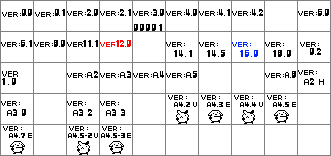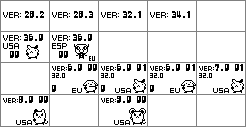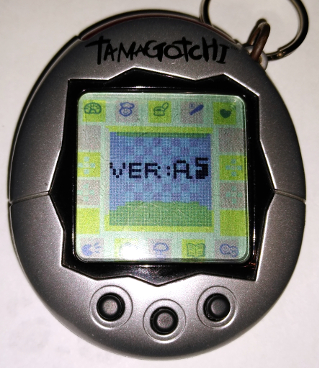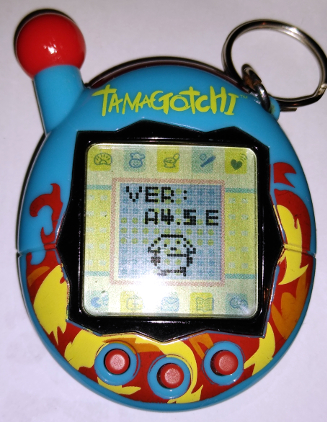Now we're in a place where, by my count, pretty much all Connection / Plus releases have at least one known ROM version associated with them, I thought I'd do a big update on all the known ROM versions so far across the entire Tamagotchi series. I've also got something else concerning the development of Tamagotchis which I'll be making a post about soon, but we'll get to that later.
The Test Mode was actually still present as far back as the Vintage releases (activated by pressing A+Reset on these versions), but the version number was not part of this mode. The first version to present the player with information about the firmware of the device was the V1:
Tamagotchi Plus / Tamagotchi Connection / Tamagotchi Connexion and Deka Tamagotchi
The V1 is probably the version that has been researched the most, due to its wide range of version differences. The following are all the versions that have been observed on a V1 so far, with a description of each version:
0.0 - Tamagotchi Plus
By the looks of it, this is the only ROM version that ordinary Tamagotchi Plus devices use.
0.1 - Tamagotchi Plus GLAY Expo Edition
A special edition of the Plus with a unique character replacing the characters that the Matchmaker normally brings.
2.0 - Tamagotchi Connexion
The earliest wave of European and Australian shells used this version.
2.1 - Tamagotchi Connexion
Later releases used this version.
2.3 - Tamagotchi Connexion
Has so far only been observed via the region change procedure on a device with ROM version 4.1 - it is currently unknown if any devices run this version without region changing.
3.0 - Deka Tamagotchi (Unreleased English Version)
Behaves exactly like a Deka Tamagotchi but in English. Can only be accessed by performing the region change procedure on a device with ROM version 4.2.
4.0 - Tamagotchi Connection
Used by the earliest batch of American shells.
4.1 - Tamagotchi Connection
Later batches of the first wave of shells used this version.
4.2 - Tamagotchi Connection
Later waves used this version.
Missing versions
A Spanish version is known to exist, but its ROM version has not yet been identified. Version 2.3 is yet to be observed without region changing, and it is thought that version 2.2 also exists but has not been seen yet. Later batches of European and Australian shells are most likely to feature new ROM versions - in fact, just today I noticed that some European V1s used the same plastic packaging as the V2 while others don't - the only difference is that the V2 packaging has a slightly raised region around where it says "Version 2", while the original V1 packaging does not feature this as there is no corresponding label for "Version 1". The current plan is to keep checking the version on more devices in case any of them feature new version numbers. The original Deka Tamagotchi is understood to have ROM version 1.0, but no device has been checked to prove this yet.
Later International Releases (2005 - 2008)
A.2 - Tamagotchi Connection V2
Early releases of the US version of the V2 - though, for unknown reasons, these devices were released in Europe instead and the US release date for the V2 was pushed from March 2005 to June 2005. In addition, the "first wave" was replaced with a new first wave of shells when the V2 released in the US.
A.3 - Tamagotchi Connexion Version 2
Early releases of the European version of the V2 used this version. Both A.2 and A.3 can be identified by the fact they use different item names - for example, "Honey" was called "Love Potion" on these early versions.
A.4 - Tamagotchi Connection V2
Later US releases of the V2.
A.5 - Tamagotchi Connexion Version 2
Later European and Australian releases of the V2.
A.8 - Tamagotchi Connection V2
Spanish language version of the V2. Interestingly, the shell designs from the "cancelled" first wave of US shells was used for this version.
A2 H - Tamagotchi Connexion Version 2 - PUMA Edition
A unique version of the V2 released in Europe with a different start up animation and egg sprite.
A3 0 - Tamagotchi Connection V3
Early releases of the V3 in the US.
A3 2 - Tamagotchi Connection V3
Later releases of the V3 in the US.
A3 3 - Tamagotchi Connexion V3
Later releases of the V3 in Europe.
A4.2 U - Tamagotchi Connection V4
Early releases of the V4 in the US.
A4.3 E - Tamagotchi Connexion Jinsei Version 4
Early releases of the V4 in Europe.
A4.4 U - Tamagotchi Connection V4
Later releases of the V4 in the US.
A4.5 E - Tamagotchi Connexion Jinsei Version 4
Later releases of the V4 in Europe.
A4.7 E - Tamagotchi Connexion Jinsei Version 4
Later releases of the V4 in Europe.
A4.5-2 U - Tamagotchi Connexion V4.5
US V4.5.
A4.5-3 E - Tamagotchi Connexion Jinsei Plus Version 4
European V4.5.
Missing versions
Spanish versions of the V3, V4 and V4.5 are missing. A.6 (likely a very late US V2 version), A.7 (likely a very late European V2 version), A3 1 (likely an early European V3 version) and A4.6 (likely a late US V4 version) seem to be missing. A4.7 E was only recently discovered, which suggests there may be more rare ROM versions for other releases, too.
Later Japanese Releases (2005 - 2008)
The Japanese releases after the Plus continued the version numbering system it used.
6.0 - Keitai
Early releases.
6.1 - Keitai
Later releases. The Hello Kitty item was replaced with a Bunny.
8.0 - Hanerutchi
11.1 - Ouchi no Dekatama
12.0 - Akai
14.1 - Entama
14.5 - Entama CYOI Change
16.0 - Uratama
18.0 - Hanerutchi 2
21.2 - TamaSuku 1
23.0 - TamaSuku 2
27.2 - TamaFure
0.2 - Oden-Kun
Seems to use its own version numbering, possibly filling the gap of 0.2 that comes after 0.0 and 0.1.
1.0 - Ouchi no Dekatama Game King
Seems to use its own version numbering, with a version screen which differs from previous releases.
Missing versions
Other Dekatama versions (Dekatama Shop, Tamatama Market, Royal Market, Game Center, Jukutama) are missing. It may be the case that there exist other versions before or after those listed above, like 14.0 or 16.1.
Tamagotchi Connection V5 / Tamagotchi Familitchi Connexion / Famitama
28.2 - Famitama
Japanese release, first wave version.
28.3 - Famitama
Japanese release, second wave version.
32.1 - Tamagotchi Connection V5
US release.
34.1 - Tamagotchi Familitchi Connexion
European release.
36.0 - Royal Famitama
Japanese release.
36.0 USA 00 - Tamagotchi Connection V5 Celebrity
US release.
36.0 ESP 00 EU - Tamagotchi Connection V5 Celebrity
Spanish language release.
Missing versions
The Spanish language version of the V5 is missing. 28.0, 28.1, 32.0 and 34.0 may also exist. There was also a special Otokitchi dating station in some Tamadepa stores, but it is likely that these are no longer accessible to anyone.
Later International Releases (2009 - 2015)
6.0 00 32.0 0 USA - Tamagotchi Music Star
Wave 1 US release, later batches - early batches were mistakenly given the European version. This screen is not pictured above as I have not yet seen a photo of its version screen.
6.0 00 32.0 0 EU - Tamagotchi Music Star
Early European releases.
6.0 01 32.0 0 USA - Tamagotchi Music Star
Wave 2 US release.
6.0 01 32.0 0 EU - Tamagotchi Music Star
Later European releases.
7.0 01 32.0 USA - Tamatown Tama-Go
US release.
8.0 00 USA - Tamagotchi Friends
Wave 1 release (often called "European", but the version is a USA version)
9.0 00 USA - Tamagotchi Friends Dream Town Digital Friend
US release.
Missing versions
Spanish Music Star, Portuguese Tama-Go, Russian Friends and wave 2 Friends.
Tamagotchi Plus Color, Tamagotchi iD, Tamagotchi iDL and Tamagotchi P's (2008 - 2013)
Later Japanese releases seem to use a build date instead of a decimal point sub-version.
40; 08-10-22 - Tamagotchi Plus Color
40; 08-11-14 - Tamagotchi Plus Color
42; 09-06-11 - Hexagontchi
43; 10-02-25 - Tamagotchi iD
49; 10-09-09 - Tamagotchi iD Station
50; 11-01-14 - Tamagotchi iDL
53; 12-04-30 - Tamagotchi iDL
English language release. I don't know why the screen is green on this version.
54; 11-09-05 - Tamagotchi iDL 15th Anniversary
55; 11-12-22 - Tamagotchi iDL Princess Spacy Version
56; 13-01-06 - Tamagotchi P's
Missing versions
iD Spot, Conan iD, Lovely Melody iD, iDL Spot, other firmware versions of the above releases.
Tamagotchi 4U, Tamagotchi 4U+, Tamagotchi M!x and Tamagotchi Meets (2014 - 2019)
The version numbering was reset from 001 in the Tamagotchi 4U.
001; 14-08-14 - Tamagotchi 4U
014; 16-08-04 - Tamagotchi M!x - Melody M!x
015; 16-09-26 - Tamagotchi M!x - Anniversary M!x
021 - Tamagotchi M!x - Gift M!x
I don't yet have the ROM version screen for this version, so I'm not sure what its build date is.
030; 18-10-19 - Tamagotchi Meets - Fairytale Meets
031; 18-10-19 - Tamagotchi Meets - Magical Meets
Missing versions
4U+, Spacy M!x, Dream M!x, Sanrio M!x, M!x Station, Pastel Meets, Sanrio Meets, Fantasy Meets, Meets Station, Tamagotchi On, possibly more firmware versions for each?
Other Devices
Many other devices have firmware version numbers that do not fit the numbering schemes of the main series.
0 - P1 2018 Rerelease, Japan
1 - P1 2018 Rerelease, USA
3 - P2 2018 Rerelease, Japan
5 - P2 2018 Rerelease, USA
71.9 - Tamagotchi Nano V1
72.0 - Tamagotchi Nano V2
No, I don't know why they use these numbers, either.
11.1 - Pocket Usatama
I don't currently have a photo of this screen.
0 20.1 - Gudetama Tamagotchi, Japan
2 20.2 - Gudetama Tamagotchi, USA
0 30.1 - Eevee Tamagotchi
1.0 - Tamagotchi Chibi, Japan
and
1.0 - Tamagotchi Chibi 2017 Rerelease, Japan
The characters differ between the different releases of the Mini, so I'm not sure why they use the same version.
2.0 - Tamagotchi Mini 2017 Rerelease, USA
1.0 - TamagoChu
And, possibly my favourite ROM version screen:
TAMA・P V1-00 - TamaWalkie
Perhaps the P is for Pedometer?
Missing versions
Other mini / chibi versions, the 2019 Usatama and Usapiyo, and perhaps there's other devices too.
I think I need to go and lie down after all that. I hope you all find this interesting! I'll be making the next post soon - we'll be taking a look at some Tamagotchi design documents.
























